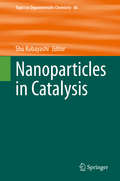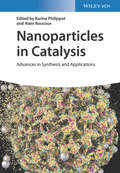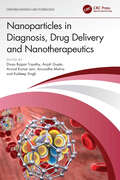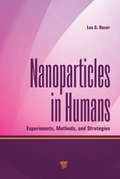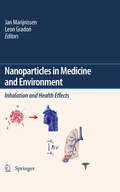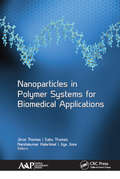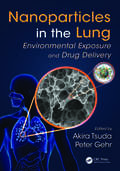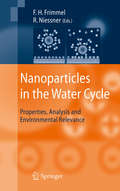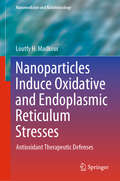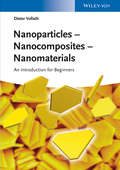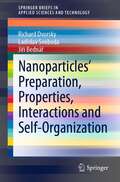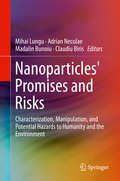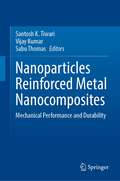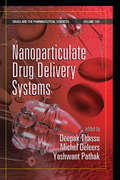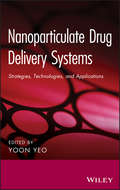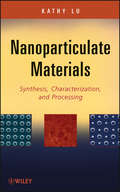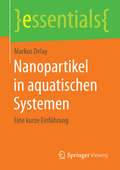- Table View
- List View
Nanoparticles in Catalysis (Topics in Organometallic Chemistry #66)
by Shū KobayashiThis volume discusses the great potential of metal nanoparticle catalysts for complicated molecular synthesis and reviews the current progress of this field. The development of highly active and stable heterogeneous catalysts is a crucial subject in modern science. However, development of heterogeneous catalysts for fine chemical synthesis has lagged far behind those for bulk chemical process. In recent years metal nanoparticle catalysts have been of great interest in this area due to their unique activity, ease of heterogenization, and robustness. Therefore, metal nanoparticle catalysts are an excellent candidate for the above-mentioned active and robust heterogeneous catalysts and this book provides an overview of this area. The present volume summarizes recent progress on nanoparticle catalysis for various organic transformations from simple redox reactions to complex asymmetric C–C bond forming reactions and also presents seminal studies on new technologies. It comprehensively summarizes advances in metal nanoparticle catalysis across several aspects including reaction manners, mechanistic investigations and new synthetic methodologies to encourage the use of metal nanoparticle catalysts for future organic synthesis. This volume will be of interest to students, researchers and professionals focused on the next-generation of fine chemical synthesis.
Nanoparticles in Catalysis: Advances in Synthesis and Applications
by Karine PhilippotDiscover an essential overview of recent advances and trends in nanoparticle catalysis Catalysis in the presence of metal nanoparticles is an important and rapidly developing research field at the frontier of homogeneous and heterogeneous catalysis. In Nanoparticles in Catalysis, accomplished chemists and authors Karine Philippot and Alain Roucoux deliver a comprehensive guide to the key aspects of nanoparticle catalysis, ranging from synthesis, activation methodology, characterization, and theoretical modeling, to application in important catalytic reactions, like hydrogen production and biomass conversion. The book offers readers a review of modern and efficient tools for the synthesis of nanoparticles in solution or onto supports. It emphasizes the application of metal nanoparticles in important catalytic reactions and includes chapters on activation methodology and supported nanoclusters. Written by an international team of leading voices in the field, Nanoparticles in Catalysis is an indispensable resource for researchers and professionals in academia and industry alike. Readers will also benefit from the inclusion of: A thorough introduction to New Trends in the Design of Metal Nanoparticles and Derived Nanomaterials for Catalysis An exploration of Dynamic Catalysis and the Interface Between Molecular and Heterogeneous Catalysts A practical discussion of Metal Nanoparticles in Water: A Relevant Toolbox for Green Catalysis A concise treatment of the opportunities and challenges of CO2 Hydrogenation to Oxygenated Chemicals Over Supported Nanoparticle Catalysts Perfect for catalytic, organic, inorganic, and physical chemists, Nanoparticles in Catalysis will also earn a place in the libraries of chemists working with organometallics and materials scientists seeking a one-stop resource with expert knowledge on the synthesis and characterization of nanoparticle catalysis.
Nanoparticles in Catalysis: Advances in Synthesis and Applications
by Karine Philippot Alain RoucouxDiscover an essential overview of recent advances and trends in nanoparticle catalysis Catalysis in the presence of metal nanoparticles is an important and rapidly developing research field at the frontier of homogeneous and heterogeneous catalysis. In Nanoparticles in Catalysis, accomplished chemists and authors Karine Philippot and Alain Roucoux deliver a comprehensive guide to the key aspects of nanoparticle catalysis, ranging from synthesis, activation methodology, characterization, and theoretical modeling, to application in important catalytic reactions, like hydrogen production and biomass conversion. The book offers readers a review of modern and efficient tools for the synthesis of nanoparticles in solution or onto supports. It emphasizes the application of metal nanoparticles in important catalytic reactions and includes chapters on activation methodology and supported nanoclusters. Written by an international team of leading voices in the field, Nanoparticles in Catalysis is an indispensable resource for researchers and professionals in academia and industry alike. Readers will also benefit from the inclusion of: A thorough introduction to New Trends in the Design of Metal Nanoparticles and Derived Nanomaterials for Catalysis An exploration of Dynamic Catalysis and the Interface Between Molecular and Heterogeneous Catalysts A practical discussion of Metal Nanoparticles in Water: A Relevant Toolbox for Green Catalysis A concise treatment of the opportunities and challenges of CO2 Hydrogenation to Oxygenated Chemicals Over Supported Nanoparticle Catalysts Perfect for catalytic, organic, inorganic, and physical chemists, Nanoparticles in Catalysis will also earn a place in the libraries of chemists working with organometallics and materials scientists seeking a one-stop resource with expert knowledge on the synthesis and characterization of nanoparticle catalysis.
Nanoparticles in Diagnosis, Drug Delivery and Nanotherapeutics (Emerging Materials and Technologies)
by Divya Bajpai Tripathy Anjali Gupta Arvind Kumar Jain Anuradha Mishra Kuldeep SinghThe integration of nanotechnology with biomaterials, diagnostic tools, analytical equipment, physiotherapy kits, and drug delivery agents has resulted in nanotherapeutics illustrated as a class of medicine with potential of research and development. This book illustrates synthesis, properties, and applications of nanotherapeutics in various healthcare-related issues including treatment of cancer, Alzheimer’s disease, targeted drug delivery, anti-HIV-1 nanotherapeutics, antibacterial/antiviral agents, skin therapy, and hyperthermia. Features: Consolidates different aspects of nanoparticles such as synthesis and types of nanotherapeutics in a detailed manner. Presents categorical classification of nanoparticles as therapeutics. Covers the sustainability of nanotherapeutics. Reviews fabrication and advancement of all categories of nanotherapeutics. Discusses specific applications such as in cancer therapy, skin treatments, and targeted drug delivery. This book is aimed at researchers, professionals, and senior undergraduate students in materials and medical science, biomedical engineering, and nanotechnology
Nanoparticles in Diagnosis, Drug Delivery and Nanotherapeutics (Emerging Materials and Technologies)
by Divya Bajpai Tripathy Anjali Gupta Arvind Kumar Jain Anuradha Mishra Kuldeep SinghThe integration of nanotechnology with biomaterials, diagnostic tools, analytical equipment, physiotherapy kits, and drug delivery agents has resulted in nanotherapeutics illustrated as a class of medicine with potential of research and development. This book illustrates synthesis, properties, and applications of nanotherapeutics in various healthcare-related issues including treatment of cancer, Alzheimer’s disease, targeted drug delivery, anti-HIV-1 nanotherapeutics, antibacterial/antiviral agents, skin therapy, and hyperthermia. Features: Consolidates different aspects of nanoparticles such as synthesis and types of nanotherapeutics in a detailed manner. Presents categorical classification of nanoparticles as therapeutics. Covers the sustainability of nanotherapeutics. Reviews fabrication and advancement of all categories of nanotherapeutics. Discusses specific applications such as in cancer therapy, skin treatments, and targeted drug delivery. This book is aimed at researchers, professionals, and senior undergraduate students in materials and medical science, biomedical engineering, and nanotechnology
Nanoparticles in Humans: Experiments, Methods, and Strategies
by Lev S. RuzerA peek into the literature on the environmental health implications of the rapidly developing nanotechnology industry shows that the potential problem of exposure to airborne nanoparticles has not been adequately addressed. The health and safety of nanotechnology workers are of concern because these groups run the greatest risk of exposure to elevated concentrations of nanomaterials. However, a gap exists between the currently available particle measurement methods and those appropriate for the assessment of nanoaerosol exposure. This book presents new ideas and methods to measure the surface area and local deposition of nanoparticles in the lungs and the true value of respirators. It proposes a nanoparticle dosimetric road map that can be used as a general strategy for the assessment of the dose, which is the most important physical cause of adverse effects on health in the case of nanoparticle exposure. The book suggests the use of 1 nm radioactive particles, called unattached activity of radon progeny, as a safe experimental tool for nanoparticle studies, including human studies. It discusses the problems related to the general strategy of risk assessment in nanoparticle exposure and concrete parameters related to dosage. The ideas presented in this book help close the gaps in our knowledge of aerosols in the nanometer range and improve our understanding of nanoparticle behavior in the air and in the human body.
Nanoparticles in Humans: Experiments, Methods, and Strategies
by Lev S. RuzerA peek into the literature on the environmental health implications of the rapidly developing nanotechnology industry shows that the potential problem of exposure to airborne nanoparticles has not been adequately addressed. The health and safety of nanotechnology workers are of concern because these groups run the greatest risk of exposure to elevated concentrations of nanomaterials. However, a gap exists between the currently available particle measurement methods and those appropriate for the assessment of nanoaerosol exposure. This book presents new ideas and methods to measure the surface area and local deposition of nanoparticles in the lungs and the true value of respirators. It proposes a nanoparticle dosimetric road map that can be used as a general strategy for the assessment of the dose, which is the most important physical cause of adverse effects on health in the case of nanoparticle exposure. The book suggests the use of 1 nm radioactive particles, called unattached activity of radon progeny, as a safe experimental tool for nanoparticle studies, including human studies. It discusses the problems related to the general strategy of risk assessment in nanoparticle exposure and concrete parameters related to dosage. The ideas presented in this book help close the gaps in our knowledge of aerosols in the nanometer range and improve our understanding of nanoparticle behavior in the air and in the human body.
Nanoparticles in medicine and environment: Inhalation and health effects
by J. C. Marijnissen Leon GradonA huge effort is put into the science of nanoparticles and their production. In many cases it is unavoidable that nanoparticles are released into the environment, either during the production processes or during the use of a product made from these particles. It is also realized that combustion processes like traffic and power plants release nanoparticles into the atmosphere. However it is not known how nanoparticles interact with the human body, especially upon inhalation. At the same time research activities are devoted to understand how nano-sized medicine particles can be used to administer medicines via inhalation. In any case it is absolutely necessary to know how the nanoparticles interfere with the inhalation system, how they deposit and affect on the human system. Three main themes are discussed: Nanoparticle sources and production Nanoparticle inhalation and deposition Toxicological and medical consequences of nanoparticles Each theme is covered comprehensively, starting at nano-quantum effects up to technical and medical applications such as measuring equipment and inhalation instrumentation. This book brings together all sub-disciplines in the field related to aerosol nanoparticles. Each chapter is written by a world expert, giving the state of the art information and challenging open questions. The last chapter summarizes in an interdisciplinary way what is already known and what still is ahead of us.
Nanoparticles in Polymer Systems for Biomedical Applications
by Sabu Thomas Nandakumar Kalarikkal Jince Thomas Jiya JoseThe volume includes presentations of technological and research accomplishments along with novel approaches in nanomedicine and nanotechnology. It explores the different types of nanomedicinal drugs with their production and commercial significance. Other topics discussed are the use of natural and synthetic nanoparticles for the production of drugs, different types of nanoparticles systems, drug carriers, wound-healing antimicrobial activity, effects of natural materials in nanomedicine, and toxicity of nanoparticles. The valuable information presented in this volume will help to keep those in this field up to date on the key findings, observations, and fabrication of drugs related to nanomedicine and nanotechnology. With chapters written by prominent researchers from academia, industry, and government and private research laboratories across the world, the book will prove to be a rich resource.
Nanoparticles in Polymer Systems for Biomedical Applications
by Sabu Thomas Nandakumar Kalarikkal Jince Thomas Jiya JoseThe volume includes presentations of technological and research accomplishments along with novel approaches in nanomedicine and nanotechnology. It explores the different types of nanomedicinal drugs with their production and commercial significance. Other topics discussed are the use of natural and synthetic nanoparticles for the production of drugs, different types of nanoparticles systems, drug carriers, wound-healing antimicrobial activity, effects of natural materials in nanomedicine, and toxicity of nanoparticles. The valuable information presented in this volume will help to keep those in this field up to date on the key findings, observations, and fabrication of drugs related to nanomedicine and nanotechnology. With chapters written by prominent researchers from academia, industry, and government and private research laboratories across the world, the book will prove to be a rich resource.
Nanoparticles in the Lung: Environmental Exposure and Drug Delivery
by Akira Tsuda Peter GehrNanoparticles have a physical dimension comparable to the size of molecular structures on the cell surface. Therefore, nanoparticles, compared to larger (e.g., micrometer) particles, are considered to behave differently when they interact with cells. Nanoparticles in the Lung: Environmental Exposure and Drug Delivery provides a better understanding
Nanoparticles in the Water Cycle: Properties, Analysis and Environmental Relevance
by Fritz H. H. Frimmel R. NiessnerAs nanotechnology enters everyday life, engineered nanoparticles (ENP) will find their way into nature, including surface and groundwater. Here, distinguished experts of water chemistry present dedicated methods for the analysis of nanoparticles in the aquatic environment, their distribution and fate. This includes the influence of complex matrices such as wastewater, brown water with natural organic matter (NOM), and high salt concentrations as well as available and future standardized methods. The background of geogenic, natural nanoparticles is considered in a discussion of known environmental effects, including strategies to test for potential effects on human and environmental health.
Nanoparticles Induce Oxidative and Endoplasmic Reticulum Stresses: Antioxidant Therapeutic Defenses (Nanomedicine and Nanotoxicology)
by Loutfy H. MadkourThis book provides insights and tools for better understanding redox biology and medicine and, in the long run, to finding new therapeutic strategies to target dysregulated redox processes in various diseases. It presents the recent advances in new nanomedication technologies of the effects of nanoparticles NPs on oxidative stress, RONS and ER stress. The book comprises 13 chapters covering ecotoxicology, cytotoxicity, nanotoxicity and genotoxicity mechanisms causing by the role and interactions of nanoparticles and free radicals with (RONS) and (ER) stress. Endoplasmic Reticulum (ER) Stress as a mechanism for NPs induced toxicity has been discussed. The advances of nanotechnology and the effects of nanoparticles on oxidative stress, ROS and ER stress parameters are discussed. Antioxidants, therapeutic options and regulation of the immune responses are explained throughout the book.
Nanoparticles - Nanocomposites – Nanomaterials: An Introduction for Beginners
by Dieter VollathMeeting the demand for a readily understandable introduction to nanomaterials and nanotechnology, this textbook specifically addresses the needs of students - and engineers - who need to get the gist of nanoscale phenomena in materials without having to delve too deeply into the physical and chemical details. The book begins with an overview of the consequences of small particle size, such as the growing importance of surface effects, and covers successful, field-tested synthesis techniques of nanomaterials. The largest part of the book is devoted to the particular magnetic, optical, electrical and mechanical properties of materials at the nanoscale, leading on to emerging and already commercialized applications, such as nanofluids in magnetic resonance imaging, high-performance nanocomposites and carbon nanotube-based electronics. Based on the author's experience in teaching nanomaterials courses and adapted, in style and level, for students with only limited background knowledge, the textbook includes further reading, as well as information boxes that can be skipped upon first reading.
Nanoparticles - Nanocomposites – Nanomaterials: An Introduction for Beginners
by Dieter VollathMeeting the demand for a readily understandable introduction to nanomaterials and nanotechnology, this textbook specifically addresses the needs of students - and engineers - who need to get the gist of nanoscale phenomena in materials without having to delve too deeply into the physical and chemical details. The book begins with an overview of the consequences of small particle size, such as the growing importance of surface effects, and covers successful, field-tested synthesis techniques of nanomaterials. The largest part of the book is devoted to the particular magnetic, optical, electrical and mechanical properties of materials at the nanoscale, leading on to emerging and already commercialized applications, such as nanofluids in magnetic resonance imaging, high-performance nanocomposites and carbon nanotube-based electronics. Based on the author's experience in teaching nanomaterials courses and adapted, in style and level, for students with only limited background knowledge, the textbook includes further reading, as well as information boxes that can be skipped upon first reading.
Nanoparticles’ Preparation, Properties, Interactions and Self-Organization (SpringerBriefs in Applied Sciences and Technology)
by Richard Dvorsky Ladislav Svoboda Jiří BednářThis book defines the concept of nanoparticles from the point of view of statistical physics and quantum physics. It gives an overview of their basic properties and of the basic methods of their preparation. The chapters are devoted to the problems of interactions between nanoparticles from elementary van der Waals interaction to Lifchitz macroscopic theory and Hamaker microscopic summation method. It elucidates the process of self-organization of nanoparticles released from the frozen liquid dispersion at the sublimation interface and mathematical simulations of the corresponding processes. It also presents applications of a completely new controlled sublimation technology.
Nanoparticles' Promises and Risks: Characterization, Manipulation, and Potential Hazards to Humanity and the Environment
by Mihai Lungu Adrian Neculae Madalin Bunoiu Claudiu BirisThe focus of this interdisciplinary volume is on four areas of nanoparticle research: characterization, manipulation, and potential effects on humanity and the environment. The book includes a comprehensive collection of data on industrial nanoparticle creation and the characterization of the nanoscale products of these processes. The authors describe the effects of these nanoscale structures on human health and discuss prospective implementations for detection and characterization of nanoparticles in the environment. They recommend, utilizing the most up-to-date understanding of nanotechnology, methods for limiting the negative effects of these products on the environment and human health through manipulation, sorting, and filtration.
Nanoparticles Reinforced Metal Nanocomposites: Mechanical Performance and Durability
by Santosh K. Tiwari Vijay Kumar Sabu ThomasThis book highlights recent developments related to fabrication and utilization of nanoparticle-engineered metal matrices and their composites linked to the heavy industries, temperature fasteners, high-pressure vessels, and heavy turbines, etc. The mechanical properties of newly developed metallic composites are discussed in terms of tensile modulus, hardness, ductility, crack propagation, elongation, and chemical inertness. This book presents the design, development, and implementation of state-of-the-art methods linked to nanoparticle-reinforced metal nanocomposites for a wide variety of applications. Therefore, in a nutshell, this book provides a unique platform for researchers and professionals in the area of nanoparticle-reinforced metal nanocomposites.
Nanoparticulate Drug Delivery Systems
by Deepak Thassu Michel Deleers Yashwant Vishnupant PathakWith the advent of analytical techniques and capabilities to measure particle sizes in nanometer ranges, there has been tremendous interest in the use of nanoparticles for more efficient methods of drug delivery. Nanoparticulate Drug Delivery Systems addresses the scientific methodologies, formulation, processing, applications, recent trends, and e
Nanoparticulate Drug Delivery Systems
by Deepak Thassu Michel Deleers Yashwant Vishnupant PathakWith the advent of analytical techniques and capabilities to measure particle sizes in nanometer ranges, there has been tremendous interest in the use of nanoparticles for more efficient methods of drug delivery. Nanoparticulate Drug Delivery Systems addresses the scientific methodologies, formulation, processing, applications, recent trends, and e
Nanoparticulate Drug Delivery Systems: Strategies, Technologies, and Applications
by Yoon YeoFrank discussions of opportunities and challenges point the way to new, more effective drug delivery systems Interest in nanomedicine has grown tremendously, fueled by the expectation that continued research will lead to the safe, efficient, and cost-effective delivery of drugs or imaging agents to human tissues and organs. The field, however, has faced several challenges attempting to translate novel ideas into clinical benefits. With contributions from an international team of leading nanomedicine researchers, this book provides a practical assessment of the possibilities and the challenges of modern nanomedicine that will enable the development of clinically effective nanoparticulate drug delivery products and systems. Nanoparticulate Drug Delivery Systems focuses on the rationales and preclinical evaluation of new nanoparticulate drug carriers that have yet to be thoroughly reviewed in the literature. The first chapter sets the stage with a general overview of targeted nanomedicine. The book then explores new and promising nanoparticulate drug delivery systems, including: Lipid nanoparticles for the delivery of nucleic acids Multifunctional dendritic nanocarriers Polymer drug nanoconjugates Next, the book presents new opportunities and challenges for nanoparticulate drug delivery systems, including: Clearance of nanoparticles during circulation Drug delivery strategies for combatting multiple drug resistance Toxicological assessment of nanomedicine Chapters offer state-of-the-technology reviews with extensive references to facilitate further investigation. Moreover, each chapter concludes with an expert assessment of remaining challenges, pointing the way to solutions and new avenues of research. With its frank discussions of opportunities and challenges, Nanoparticulate Drug Delivery Systems sets a solid foundation for new research leading to the discovery and development of better nanomedicines.
Nanoparticulate Drug Delivery Systems: Strategies, Technologies, and Applications
by Yoon YeoFrank discussions of opportunities and challenges point the way to new, more effective drug delivery systems Interest in nanomedicine has grown tremendously, fueled by the expectation that continued research will lead to the safe, efficient, and cost-effective delivery of drugs or imaging agents to human tissues and organs. The field, however, has faced several challenges attempting to translate novel ideas into clinical benefits. With contributions from an international team of leading nanomedicine researchers, this book provides a practical assessment of the possibilities and the challenges of modern nanomedicine that will enable the development of clinically effective nanoparticulate drug delivery products and systems. Nanoparticulate Drug Delivery Systems focuses on the rationales and preclinical evaluation of new nanoparticulate drug carriers that have yet to be thoroughly reviewed in the literature. The first chapter sets the stage with a general overview of targeted nanomedicine. The book then explores new and promising nanoparticulate drug delivery systems, including: Lipid nanoparticles for the delivery of nucleic acids Multifunctional dendritic nanocarriers Polymer drug nanoconjugates Next, the book presents new opportunities and challenges for nanoparticulate drug delivery systems, including: Clearance of nanoparticles during circulation Drug delivery strategies for combatting multiple drug resistance Toxicological assessment of nanomedicine Chapters offer state-of-the-technology reviews with extensive references to facilitate further investigation. Moreover, each chapter concludes with an expert assessment of remaining challenges, pointing the way to solutions and new avenues of research. With its frank discussions of opportunities and challenges, Nanoparticulate Drug Delivery Systems sets a solid foundation for new research leading to the discovery and development of better nanomedicines.
Nanoparticulate Materials: Synthesis, Characterization, and Processing
by Kathy LuServing as the only systematic and comprehensive treatment on the topic of nanoparticle-based materials, this book covers synthesis, characterization, assembly, shaping and sintering of all types of nanoparticles including metals, ceramics, and semiconductors. A single-authored work, it is suitable as a graduate-level text in nanomaterials courses.
Nanoparticulate Materials: Synthesis, Characterization, and Processing
by Kathy LuServing as the only systematic and comprehensive treatment on the topic of nanoparticle-based materials, this book covers synthesis, characterization, assembly, shaping and sintering of all types of nanoparticles including metals, ceramics, and semiconductors. A single-authored work, it is suitable as a graduate-level text in nanomaterials courses.
Nanopartikel in aquatischen Systemen: Eine kurze Einführung (essentials)
by Markus DelayWas sind Nanopartikel? Was macht Nanopartikel so besonders? Antworten auf diese Fragen gibt dieses Essential, eine prägnante Einführung zu den Eigenschaften, zur Systematik und zu Anwendungen von Nanopartikeln in wässrigen Systemen. Der Fokus liegt auf dem Verhalten und der instrumentellen Analytik von Nanopartikeln im Wasser. Dabei wird ihre Relevanz sowohl für die Wasserqualität als auch für die Wassernutzung, -aufbereitung und -reinigung aufgezeigt. Wissenschaftliche Gesichtspunkte zu Nutzen und Risiken werden ebenfalls thematisiert. Eine sorgfältige Auswahl an weiterführender Literatur ermöglicht an jeder Stelle eine selbstständige Vertiefung der behandelten Fragestellungen.
